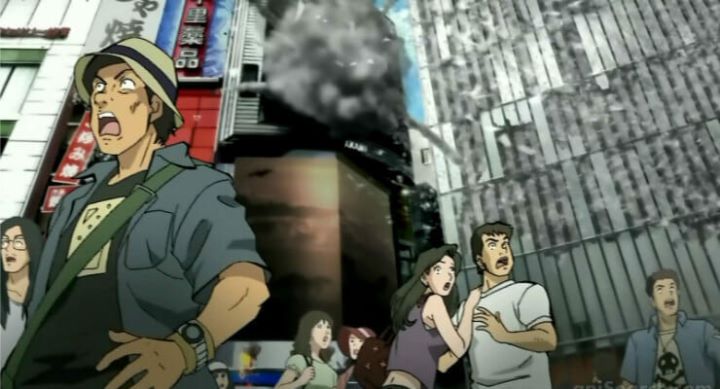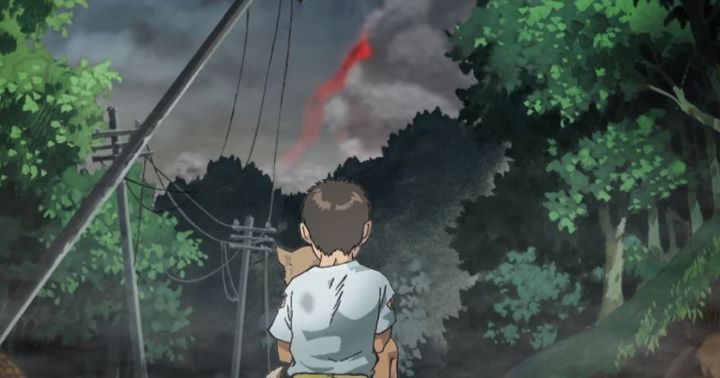






Disclaimer: This review covers the two-part film adaptation of "The Spirit of the Sun," each film being titled "The Channel" and "Borders."In the mid-2010's, Sentai Filmworks (through their Maiden Japan branch) licensed and released a couple obscure anime films. One was "A Spirit of the Sun," a two-part film series released in 2006. Produced by Madhouse, an anime studio with a great reputation for popular anime at the time (see "Death Note" and "Black Lagoon"), it's confusing on first glance why this would take over a decade to see a home video release outside of Japan. After watching it, it makes a bit more sense: it's not very good, and the merits it does have involve politics that might be difficult to commercialize.Based on a manga, the films begin in an alternate version of the year 2002. A series of massive earthquakes hit Japan, causing Mt. Fuji to erupt, and finally, causing the mainland island of Japan to split in two. The first half of the first feature-length film, "The Channel," focuses on this, through several perspectives, but mainly that of a boy named Genichiro Ryu. Genichiro is caught alone during the disaster, but manages to escape, traveling alongside another traveler bringing water and supplies to his family on the other side of the country. Genichiro's kind spirit affects those around him: even as his home collapses and his family nowhere to be seen, he stops to help those around him, and encourages others to show that same compassion.Initially, the movie doesn't make a good first impression. Part of this is poor writing and poor direction, and part is overall poor production values. We watch politicians react to the disaster: one, worried about his family, exclaims "I cannot be the last of my bloodline!", a motivation that seems less admirable than simply being worried about the safety of a fellow human. Another scene shows the Prime Minister crying for "his poor country," which reads that he's more worried about the land itself, and the thousands of years of history coming to an end, rather than the citizens about to die. These aren't completely unreasonable thoughts to have, but their character seems traditionally Japanese, and wouldn't be as relatable to the typical viewer outside the country. That's just the dialogue: scenes are edited with poor effectiveness, noticably not giving certain scenes enough time, or too much time, and not attempting to put good composition to a frame. And animation and visuals are particularly bad, with a huge lack of detail, flat colors, and limited frames of movement (or sometimes, none at all). 3D animation is used inconstently, and when it is used, no effort was made to make it blend in. As a spoiler for the rest of the story, a large part of it happens to take place in Taiwan... I wonder if the movies were secretly a co-production with a cheaper external studio, or more likely, a practice ground for Madhouse animators that normally work on background characters you aren't supposed to notice.  These elements affect a serious drama that is supposed to make us fear and feel for these victims. It was distracting. But thankfully, the story improves a bit when it shifts focus: when Genichiro was lost in the aftermath and presumed dead, we fastforward a couple decades to see him in Taiwan, working as a street food cook. After this ficitional disaster, the world changed dramatically. the USA and China each took responsibility to aid Japan, each taking a half of the broken country, and each insisting they hold power. With almost half of the population wiped out, most Japanese become refugees in neighboring countries, with a camp of over 80,000 living in Taiwan. As it becomes less likely they will ever return to their homeland, Taiwanese citizens and Japanese alike grow restless, with racism and hatred affecting everyone. It falls on Genichiro again to try to keep peace in his new home, and to stop a terrorist attack secretly organized by anti-Japanese Taiwan government officials. It's not just a drama anymore, you see, but a political thriller! And this is still within the first film, by the way: it breaks in a random story point to the second movie, "Borders." Really, this should be treated as a single nearly-three-hour film.I admit the focus change improves the movies a lot. I became genuinely interested in what would happen next. It isn't predictable: as a minor spoiler, major political issues still aren't resolved by the very end, opening up the story for a full-length sequel (I don't know if the manga already covers this). Even so, there are still a few issues. One being how Genichiro the Savior is treated, with multiple characters claiming his "words can change people." It's a hopeful but naive notion: thankfully, it isn't infallible, and stands as a good example for all of us to follow, but too much is placed on it. My second big issue is that it is a fictional story set in a very real, grounded world, dealing with potentially real political issues I'm ignorant about. It's not the first to show both pro and anti-Japanese notions, or views of the outside world looking in, or vice versa. "Code Geass" did it. But that show was set in a world that couldn't be called anything but fantasy. In this case, "A Spirit of the Sun" may very well offend some people. Actually... it goes out of its way to paint both Japanese and Taiwanese as great people, which is distracting all the same."A Spirit of the Sun" is definitely the sort of anime that could have been effective as a live-action film or mini-series. And with such poor production values in animation, a live-action effort might have been a lot better. I admit the second half of the runtime helped boost my score a lot, and I appreciate the general attempt at a more serious story. Especially with these themes, the movies remain relevant around the world, moreso now than ever before. But these are not good movies; consider looking up the manga instead.
These elements affect a serious drama that is supposed to make us fear and feel for these victims. It was distracting. But thankfully, the story improves a bit when it shifts focus: when Genichiro was lost in the aftermath and presumed dead, we fastforward a couple decades to see him in Taiwan, working as a street food cook. After this ficitional disaster, the world changed dramatically. the USA and China each took responsibility to aid Japan, each taking a half of the broken country, and each insisting they hold power. With almost half of the population wiped out, most Japanese become refugees in neighboring countries, with a camp of over 80,000 living in Taiwan. As it becomes less likely they will ever return to their homeland, Taiwanese citizens and Japanese alike grow restless, with racism and hatred affecting everyone. It falls on Genichiro again to try to keep peace in his new home, and to stop a terrorist attack secretly organized by anti-Japanese Taiwan government officials. It's not just a drama anymore, you see, but a political thriller! And this is still within the first film, by the way: it breaks in a random story point to the second movie, "Borders." Really, this should be treated as a single nearly-three-hour film.I admit the focus change improves the movies a lot. I became genuinely interested in what would happen next. It isn't predictable: as a minor spoiler, major political issues still aren't resolved by the very end, opening up the story for a full-length sequel (I don't know if the manga already covers this). Even so, there are still a few issues. One being how Genichiro the Savior is treated, with multiple characters claiming his "words can change people." It's a hopeful but naive notion: thankfully, it isn't infallible, and stands as a good example for all of us to follow, but too much is placed on it. My second big issue is that it is a fictional story set in a very real, grounded world, dealing with potentially real political issues I'm ignorant about. It's not the first to show both pro and anti-Japanese notions, or views of the outside world looking in, or vice versa. "Code Geass" did it. But that show was set in a world that couldn't be called anything but fantasy. In this case, "A Spirit of the Sun" may very well offend some people. Actually... it goes out of its way to paint both Japanese and Taiwanese as great people, which is distracting all the same."A Spirit of the Sun" is definitely the sort of anime that could have been effective as a live-action film or mini-series. And with such poor production values in animation, a live-action effort might have been a lot better. I admit the second half of the runtime helped boost my score a lot, and I appreciate the general attempt at a more serious story. Especially with these themes, the movies remain relevant around the world, moreso now than ever before. But these are not good movies; consider looking up the manga instead.